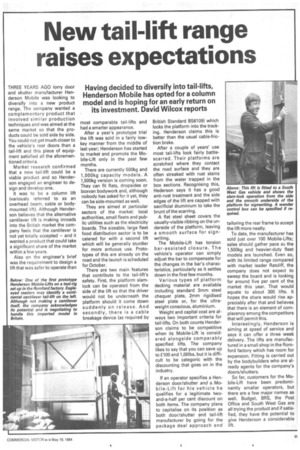New tail-lift range raises expectations
Page 83

If you've noticed an error in this article please click here to report it so we can fix it.
Having decided to diversify into tail-lifts, Henderson Mobile has opted for a column model and is hoping for an early return on its investment. David Wilcox reports
THREE YEARS AGO lorry door and shutter manufacturer Henderson Mobile was looking to diversify into a new product range. The company wanted a complementary product that involved similar production techniques and was aimed at the same market so that the products could be sold side by side. You could not get much closer to the vehicle's rear doors than a tail-lift and this piece of equipment satisfied all the aforementioned criteria.
Market research confirmed that a new tail-lift could be a viable product and so Henderson engaged an engineer to design and develop one.
It was to be a column lift (variously referred to as an overhead beam, cable or bodymounted lift). Although Henderson believes that the alternative cantilever lift is making inroads into the British market the company feels that the cantilever is not yet totally accepted — and it wanted a product that could take a significant share of the market within a few years.
Also on the engineer's brief was the requirement to design a lift that was safer to operate than most comparable tail-lifts and had a smarter appearance.
After a year's prototype trial the lift was sold in a fairly lowkey manner from the middle of last year; Henderson has started to market and promote the Mobile-Lift only in the past few months.
There are currently 500kg and 1,000kg capacity models. A 1,500kg version is coming soon. They can fit flats, dropsides or boxvan bodywork and, although nobody has asked for it yet, they can be side-mounted as well.
They are aimed at particular sectors of the market: local authorities, small fleets and public utilities such as the electricity boards. The sizeable, large fleet food distribution sector is to be catered for with a second lift which will be generally sturdier for more arduous use. Prototypes of this are already on the road and the launch is scheduled for October.
There are two main features that contribute to the tail-lift's safety. First, the platform slamlock can be operated from the side of the lift so that the driver would not be underneath the platform should it come down suddenly on release. And secondly, there is a cable breakage device (as required by British Standard BS6109) which locks the platform into the tracking. Henderson claims this is better than the usual cable-friction brake.
After a couple of years' use most tail-lifts look fairly battlescarred. Their platforms are scratched where they contact the road surface and they are often streaked with rust stains from the water trapped in the box sections. Recognising this, Hederson says it has a good anti-rust treatment and the side edges of the lift are capped with sacrificial aluminium to take the brunt of the scarring.
A flat steel sheet covers the usually-visible ribbing on the underside of the platform, leaving a smooth surface for signwriting.
The Mobile-Lift has torsion bar-assisted closure. The vehicle's operator can simply adjust the bar to compensate for the changes in the bar's characteristics, particularly as it settles down in the first few months.
Various types of platform decking material are available including standard 3mm steel chequer plate, 2mm rigidised steel plate or, for the ultraweight conscious, aluminium.
Weight and capital cost are always two important criteria for tail-lifts. On both counts Henderson claims to be competitive when its Mobile-Lift is considered alongside comparably specified lifts. The company likes to say that you can save up to 100 and 1,00Ibs, but it is difficult to be categoric with the discounting that goes on in the industry.
If an operator specifies a Henderson door/shutter and a. Mobile-Lift for his vehicle he qualifies for a legitimate twoand-a-half per cent discount on both items. The company plans to capitalise on its position as both door/shutter and tail-lift manufacturer by going for the package deal approach and tailoring the rear frame to accept the lift more neatly.
To date, the manufacturer has sold just over 100 Mobile-Lifts; sales should gather pace as the 1,500kg and heavier-duty fleet models are launched. Even so, with its limited range compared with market leader Ratcliff, the company does not expect to sweep the board and is looking for around five per cent of the market this year. That would equate to about 300 lifts. It hopes the share would rise appreciably after that and believes that there is an element of complacency among the competitors that will permit this.
Interestingly, Henderson is aiming at speed of service and says it can offer a three week delivery. The lifts are manufactured in a small shop in the Romford factory which has room for expansion. Fitting is carried out by the bodybuilders who are already agents for the company's doors/shutters.
So far, customers for the Mobile-Lift have been predominantly smaller operators, but there are a few major names as well. Budget, BRS, the Post Office and South West Gas are all trying the product and if satisfied, they have the potential to give Henderson a considerable lift.
























































































































